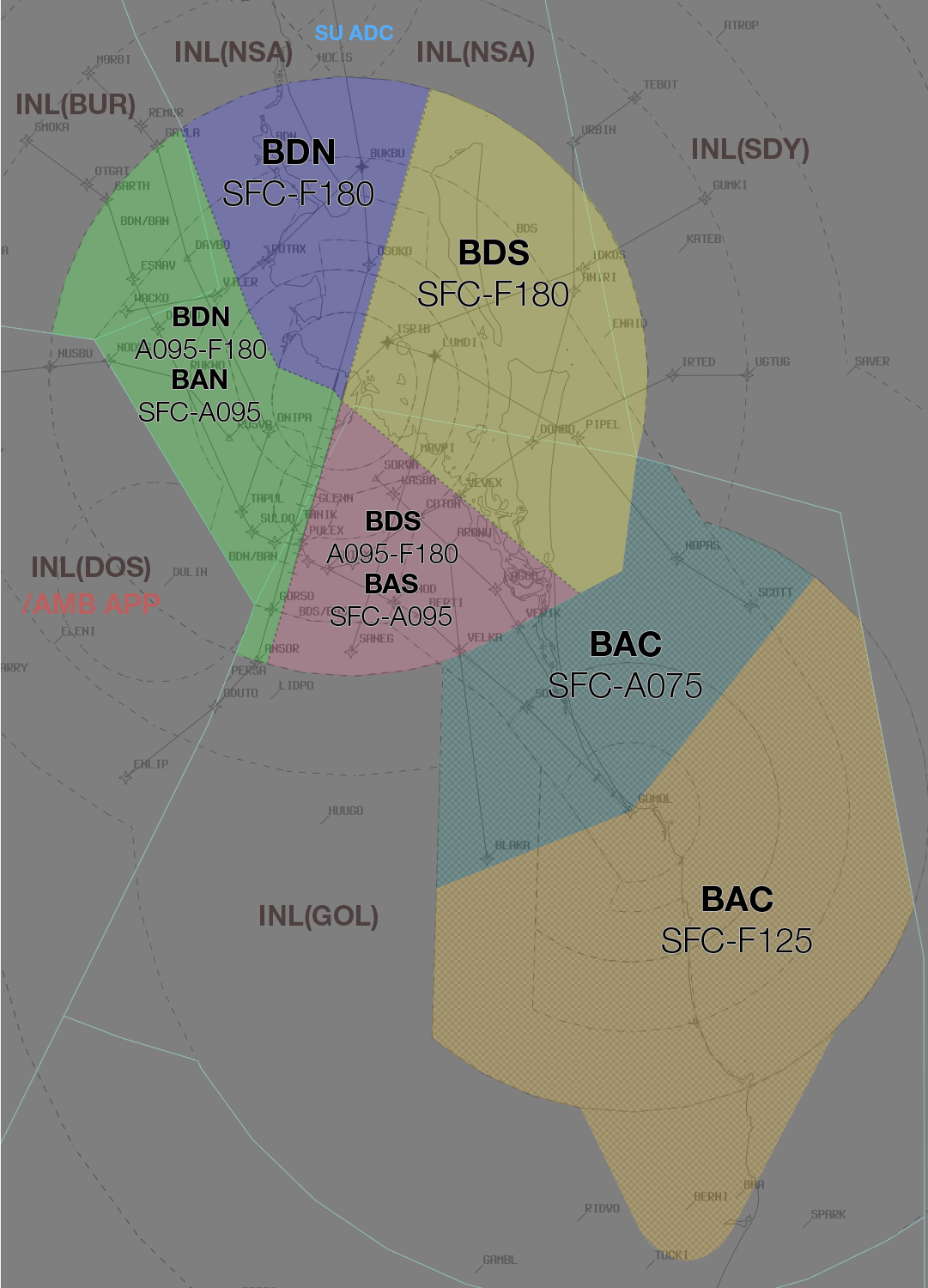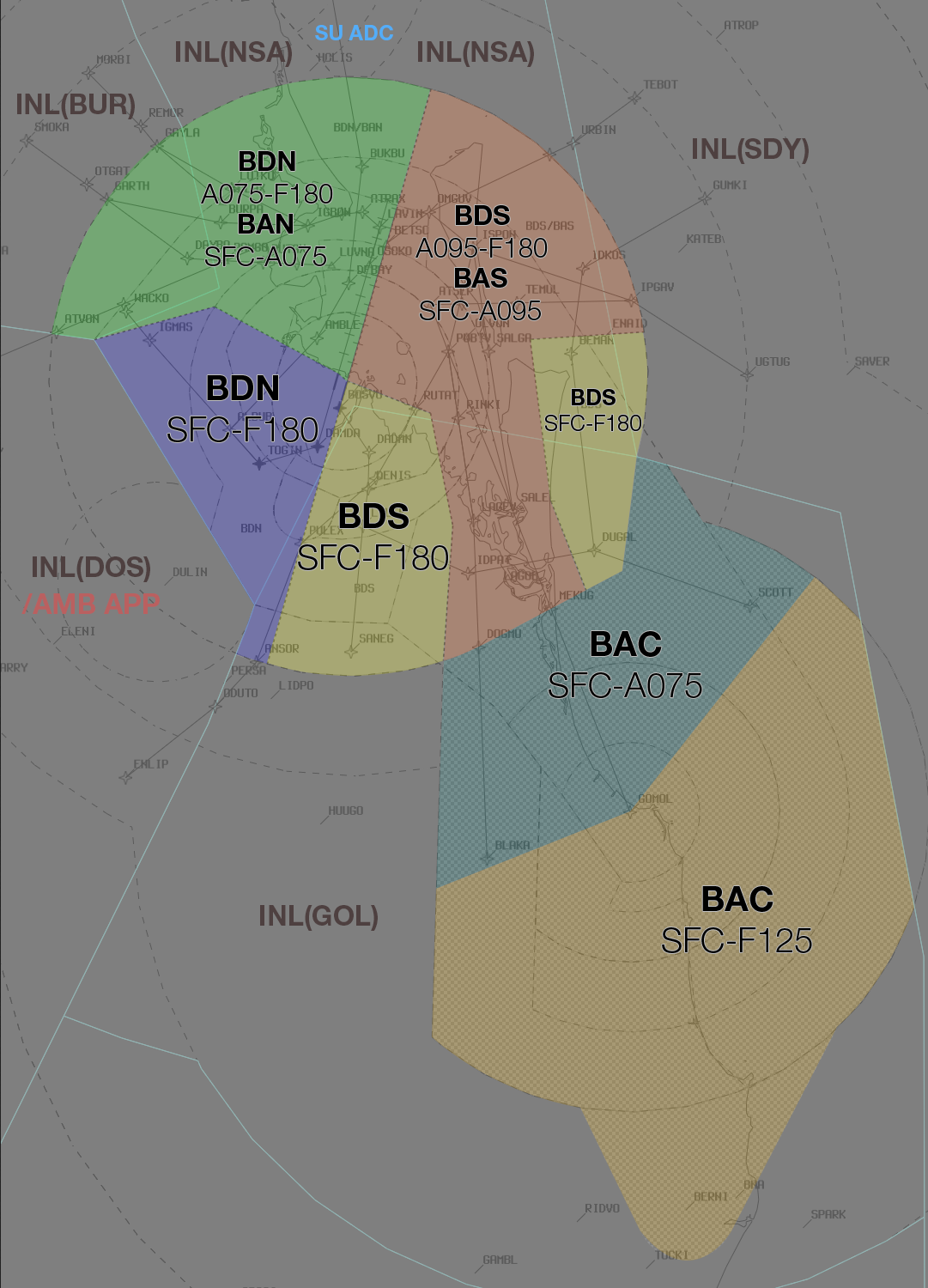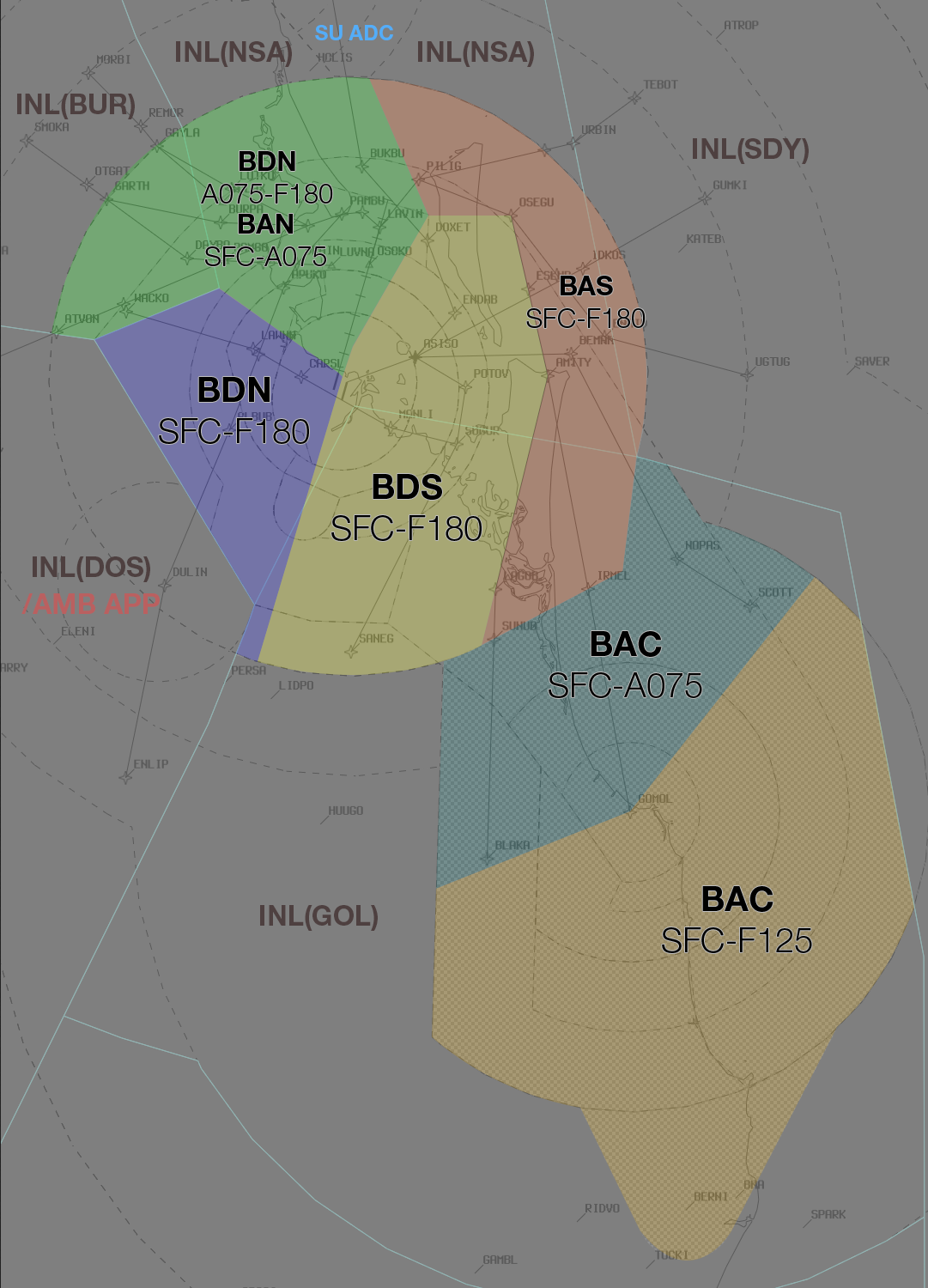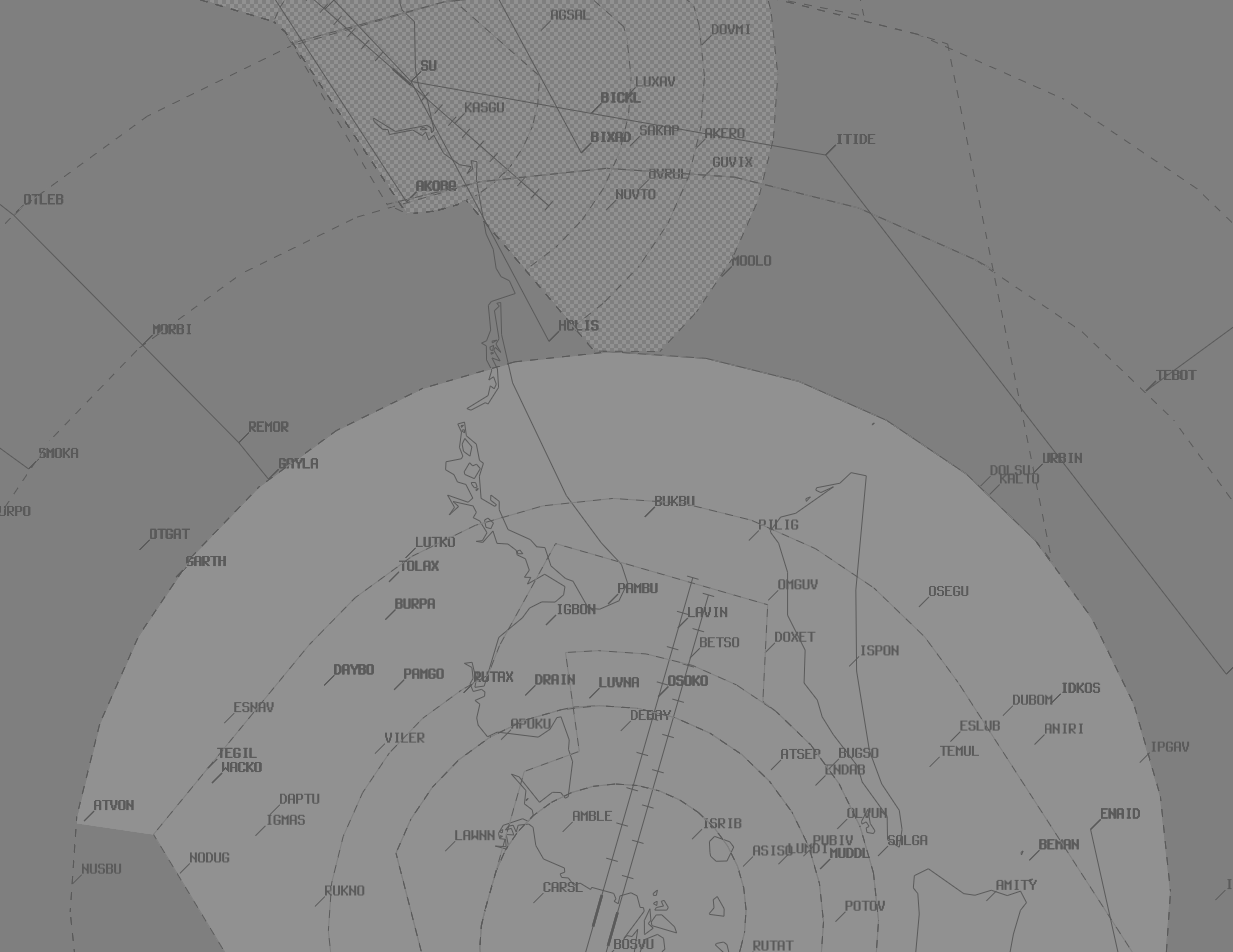Brisbane TCU
Positions
| Name | ID | Callsign | Frequency | Login Identifier |
|---|---|---|---|---|
| Brisbane Approach North | BAN | Brisbane Approach | 124.700 | BN_APP |
| Brisbane Approach South† | BAS | Brisbane Approach | 125.600 | BN-S_APP |
| Brisbane Departures North† | BDN | Brisbane Departures | 133.450 | BN_DEP |
| Brisbane Departures South† | BDS | Brisbane Departures | 118.450 | BN-S_DEP |
| Gold Coast Approach† | BAC | Brisbane Approach | 123.500 | BN-C_APP |
| Brisbane Flow† | BFL | BN_FMP |
† Non-standard positions may only be used in accordance with VATPAC Air Traffic Services Policy
Airspace
The Vertical limits of the BN TCU are SFC to F180, except in BAC airspace, where it is SFC to A075 in the North West, and SFC to F125 in the South East.
Reclassifications
AF CTR
AF CTR reverts to Class G when AF ADC is offline, and is administered by the relevant BN TCU controller.
See also: AF ADC Offline.
CG CTR
If BN TCU elects not to provide top-down to YBCG, The CG CTR Class C airspace SFC to A035 reverts to Class G when CG ADC is offline, and is administered by the relevant BN TCU controller.
See also: CG ADC Offline.
Airspace Structural Arrangements
Pursuant to Section 3 of the VATPAC Air Traffic Services Policy, “North”/”West” positions shall assume the airspace of corresponding “South”/”East” positions when the latter are inactive (e.g. BAN assumes BAS airspace), and vice versa.
Airspace Division
The divisions of the airspace between BAN, BAS, BDS, BDN, and BAC change based on the Runway Mode.
Note
The following diagrams do not include non BN TCU areas of responsibility such as AF CTR or CG ADC
01 PROPS

19 PROPS

SODPROPS

Parallel Runway Operations
Refer to Parallel Runway Separation Standards for more information
Runway Selection
Aircraft shall be assigned the following runways for arrival when PROPS are in progress:
| FF | Runway |
|---|---|
| BLAKA | 01R/19L |
| GOMOL | 01R/19L |
| UGTUG | 01R/19R |
| TEBOT | 01R/19R |
| MORBI | 01L/19R |
| SMOKA | 01L/19R |
| WOODY | 01L/19R |
| ENLIP | 01L/19L |
| Other aircraft: | |
| From the NORTH and WEST | 01L/19R |
| From the SOUTH and EAST | 01R/19L |
These standard runway assignments may be modified strategically by the BAS or BFL controller.
Example
If during an event, the vast majority of traffic is coming from BLAKA and GOMOL feeder fixes, BAS/BFL may elect to assign 19L to BLAKA arrivals and 19R to GOMOL arrivals, to keep them separated at all times.
BFL -> INL: "All arrivals via GOMOL to be assigned 19R until further notice"
INL -> BFL: "Roger, Arrivals via GOMOL to be assigned 19R"
Independent Visual Approach Phraseology at Night
"CLEARED INDEPENDENT VISUAL APPROACH RUNWAY (number), NOT BELOW (altitude) UNTIL ESTABLISHED ON THE PAPI (or GLIDEPATH)"
AF ADC Offline
Due to the low level of CTA (A015) in the AF CTR when AF ADC is offline, it is best practice to give airways clearance to aircraft at the holding point, to ensure departing aircraft can have uninterrupted climb.
Example
ABC: "Brisbane Approach, ABC, PC12, POB 8, IFR, Taxiing YBAF for YBSU, Runway 28R"
BN TCU: "ABC, Brisbane Approach, Squawk 3601, No Reported IFR Traffic, Report Ready at the Holding Point for Airways Clearance"
ABC: "Squawk 3601, Wilco, ABC"
ABC: "ABC, Ready Runway 28R, Request clearance"
BN TCU: "ABC, Cleared to YBSU via BN, Flight Planned Route. Make Visual right turn DCT BN, Climb to A030"
ABC: "Cleared to YBSU via BN, Flight Planned Route. Make Visual right turn DCT BN, Climb to A030, ABC"
CG ADC Offline
Due to the low level of CTA (A035) in the CG CTR when CG ADC is offline, it is best practice to give airways clearance to aircraft at the holding point, to ensure departing aircraft can have uninterrupted climb.
Example
JST446: "Brisbane Approach, JST446, A320, IFR, Taxiing YBCG for YSSY, Runway 214"
BN TCU: "JST446, Brisbane Approach, Squawk 3601, No Reported IFR Traffic, Report Ready at the Holding Point for Airways Clearance"
JST446: "Squawk 3601, Wilco, JST446"
JST446: "JST446, Ready Runway 14, Request clearance"
BN TCU: "JST446, Cleared to YSSY via APAGI, Flight Planned Route. Climb to A060"
JST446: "Cleared to YSSY via APAGI, Flight Planned Route. Climb to A060, JST446"
Coordination
Enroute
Departures
Voiceless for aircraft:
- With ADEP YBBN
- Tracking via a Procedural SID terminus; and
- Assigned the lower of
F180or theRFL
- With ADEP YBCG
- Tracking via APAGI and assigned the lower of
F120or theRFL; or - Tracking via BN and assigned the lower of
F180or theRFL
- Tracking via APAGI and assigned the lower of
- With ADES YBSU
- Assigned the ITIDE STAR; and
- Assigned
F130
All other aircraft going to INL CTA must be Heads-up Coordinated by BN TCU prior to the boundary. This includes YBCG departures to the North that clip INL(GOL) airspace before re-entering BN TCU airspace
Example
BAC -> GOL: "Departing YBCG, X4C, do you have any Restrictions or Requirements?"
GOL -> BAC: "X4C, No Restrictions or Requirements"
Arrivals
Voiceless for all aircraft:
- With ADES YBBN or YBCG; and
- Assigned a STAR; and
- Assigned
A090for YBBN arrivals; or - Assigned
F130for YBCG arrivals
Additionally, Voiceless coordination may be used for YBCG arrivals tracking via BN and assigned F190.
All other aircraft coming from INL CTA will be Heads-up Coordinated to BN TCU.
BN ADC
Auto Release
'Next' coordination is not required from BN ADC for aircraft that are:
a) Departing from a runway nominated on the ATIS (except during SODPROPS^); and
b) Assigned the standard assignable level; and
c) Assigned a Procedural SID
^Auto Release is not available during SODPROPS runway mode. All aircraft will be coordinated from BN ADC to BN TCU.
Example
BN ADC -> BN TCU: "Next, ABC, runway 19L"
BN TCU -> BN ADC: "ABC, Heading 030, Unrestricted"
BN ADC -> BN TCU: "Heading 030, ABC"
The Standard Assignable level from BN ADC to BN TCU is:
For Jets: A060
For Non-Jets: The lower of A040 or the RFL
CG ADC
Airspace
CG ADC is responsible for the Class C Airspace within the CG CTR SFC to A015.
Refer to Reclassifications for operations when CG ADC is offline.
Auto Release
'Next' coordination is not required from CG ADC for aircraft that are:
a) Departing from a runway nominated on the ATIS; and
b) Assigned the standard assignable level; and
c) Assigned a Procedural SID
Example
CG ADC -> BAC: "Next, CBN, runway 14"
BAC -> CG ADC: "CBN, heading 030, unrestricted"
CG ADC -> BAC: "Heading 030, CBN"
The BN TCU controller can suspend/resume Auto Release at any time, with the concurrence of CG ADC.
The Standard Assignable level from CG ADC to BN TCU is:
For Jets: A060
For Non-Jets: The lower of A060 or the RFL
AF ADC
Airspace
AF ADC is responsible for the Class D Airspace within the AF CTR SFC to A015.
Refer to Reclassifications for operations when AF ADC is offline.
Departures
When aircraft planned via a CTA departure are ready for takeoff and expected to depart imminently, AF ADC shall seek release of the aircraft through a 'Next' call.
Example
AF ADC -> BN TCU: "Next, XMM, Runway 10L"
BN TCU -> AF ADC: "XMM, Unrestricted"
AF ADC -> BN TCU: "XMM"
The Standard Assignable level from AF ADC to BN TCU is the lower of A040 or the RFL, any other level must be prior coordinated.
Arrivals/Overfliers
BN TCU will heads-up coordinate arrivals/overfliers from Class C to AF ADC prior to 5 mins from the boundary.
IFR aircraft will be cleared for the coordinated approach (Instrument or Visual) prior to handoff to AF ADC, unless AF ADC nominates a restriction.
VFR aircraft require a level readback.
Example
BN TCU -> AF ADC: "via TVT for the visual approach, UJE"
AF ADC -> BN TCU: "UJE, visual approach"
AMB TCU
All aircraft transiting from BN TCU to AMB TCU and vice versa must be heads-up coordinated prior to the boundary.
Example
AMB TCU -> BN TCU: "via BN, DRGN02"
BN TCU -> AMB TCU: "DRGN02, F140"
For aircraft arriving into AMB TCU there is no standard assignable level and simply is what ever the controllers agree upon.
Example
BN TCU -> AMB TCU: "via WACKO, STAL13, what level can I assign?"
AMB TCU -> BN TCU: "STAL13, A090"
BN TCU -> AMB TCU: "A090, STAL13"
SU ADC
BN TCU Class G shares a tiny border with SU ADC, however there are no SIDs, STARs, or airways through this gap. The only possible way for an aircraft to directly enter SU ADC airspace from BN TCU's jurisdiction, is from Class G, and as such, no coordination is required to SU ADC. However, ensure the aircraft is transferred to the ADC at least 10nm prior to the boundary, to facilitate their airways clearance.

SU ADC coordination for arrivals and departures via the SID/STAR is handled by INL(NSA).